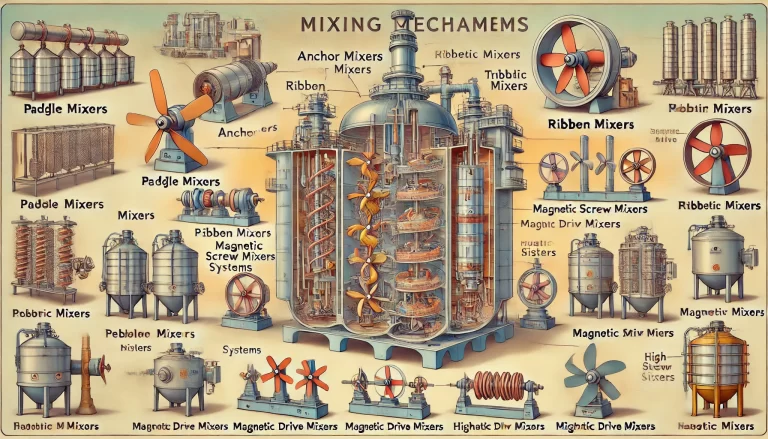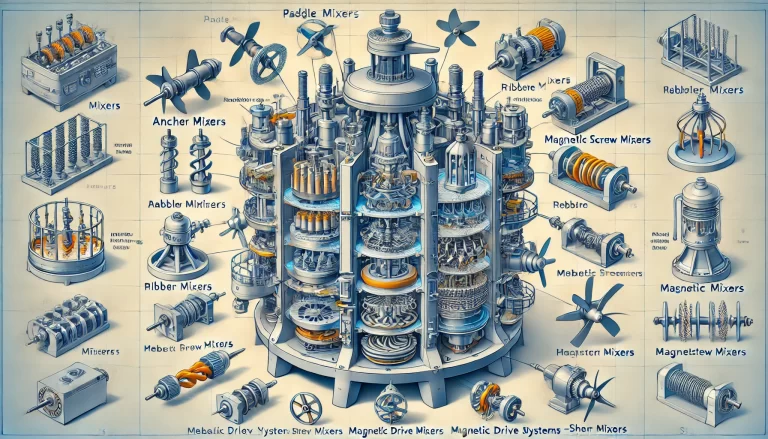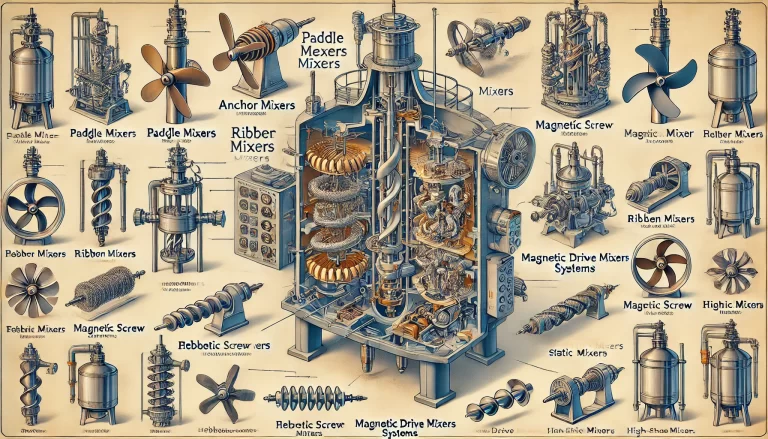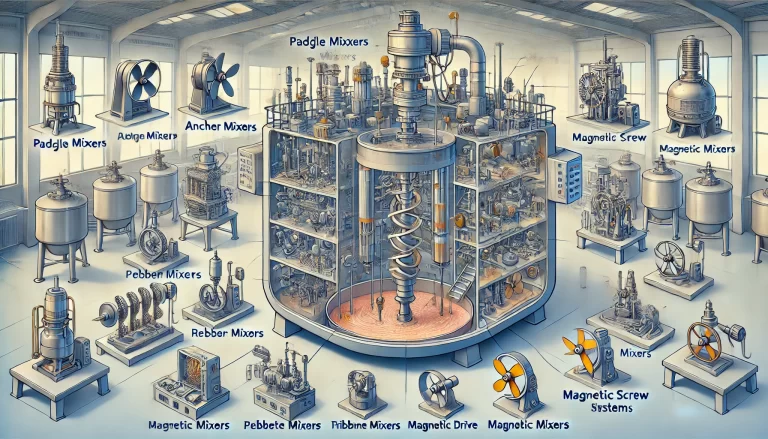Mixing is a crucial operation in reactors, particularly in chemical, pharmaceutical, and material processing industries. The type of agitator or mixing mechanism used in a reactor determines the efficiency of operations like heat transfer, mass transfer, and chemical reactions. Here’s a detailed look at the common types of mixing methods and their applications.
1. Paddle (Flat-Blade) Mixers
- Structure: Paddle mixers consist of flat or slightly angled blades attached to a rotating shaft. The design is simple and economical.
- Function: These mixers provide gentle agitation suitable for low-viscosity liquids. The flow pattern is radial, promoting homogeneity without excessive turbulence.
- Applications: Often used in processes like blending of fluids, dissolution of solids, and simple heat transfer applications in industries such as chemicals and food processing.
2. Anchor Mixers
- Structure: Anchor-shaped agitators have blades that hug the walls of the reactor, often equipped with scrapers.
- Function: Designed for high-viscosity materials, these mixers ensure the entire content, including the material near the walls, is mixed uniformly. The scrapers prevent materials from sticking to the wall, enhancing heat transfer efficiency.
- Applications: Used in manufacturing viscous products such as adhesives, polymers, and coatings.

3. Ribbon (Helical) Mixers
- Structure: A helical ribbon design, often dual-layered, facilitates axial and radial flow.
- Function: These mixers excel at blending highly viscous materials and creating a uniform temperature distribution. The dual helical ribbons promote upward and downward motion of the material, ensuring thorough mixing.
- Applications: Ideal for processes requiring consistent mixing of high-viscosity materials, such as in the production of creams, pastes, and other dense fluids.
4. Propeller Mixers
- Structure: Similar to a marine propeller, these mixers have blades angled to create axial flow patterns.
- Function: These mixers generate high shear forces and turbulence, making them suitable for rapid mixing of low-viscosity fluids.
- Applications: Widely used in water treatment, petrochemical processes, and fermentation tanks where quick mixing or strong circulation is required.
5. Turbine Mixers
- Structure: Turbine mixers typically have multiple flat or curved blades mounted on a disk.
- Function: Known for their high shear capability, these mixers create turbulence and are highly effective for mixing immiscible liquids or suspending solids. They promote gas-liquid and liquid-liquid mass transfer.
- Applications: Common in chemical reactors for emulsification, dispersion of gas into liquids, and suspension of fine particles.
6. Helical Screw Mixers
- Structure: Consist of a spiral screw blade mounted vertically or horizontally in the reactor.
- Function: These mixers are used for processes requiring vertical movement of materials, often moving denser materials upwards and lighter materials downwards.
- Applications: Particularly effective in high-viscosity material handling, such as the mixing of dough, pastes, or heavy slurries.

7. Magnetic Drive Mixers
- Structure: These mixers use a magnetic coupling to drive the agitator, eliminating the need for mechanical seals.
- Function: They provide a contamination-free environment by ensuring the reactor remains completely sealed. This makes them ideal for sterile conditions.
- Applications: Extensively used in pharmaceutical, food, and biotech industries where sterility and containment are critical.
8. Dual-Agitator Systems
- Structure: Dual systems combine two types of agitators, such as a high-speed disperser and a slow-speed anchor mixer, within the same reactor.
- Function: These systems can simultaneously provide high shear for dispersion and low-speed mixing for uniformity, making them versatile.
- Applications: Perfect for complex processes requiring simultaneous heat transfer and material blending, such as in cosmetics and specialty chemicals.
9. High-Shear Mixers
- Structure: Feature rotating blades that operate at very high speeds to create intense shear forces.
- Function: High-shear mixers break down particles and emulsify immiscible liquids, ensuring a fine dispersion or homogenization.
- Applications: Ideal for emulsions, suspensions, and processes like polymerization and nanoparticle synthesis.

10. Static Mixers
- Structure: Unlike other mixers, static mixers consist of stationary internal elements that mix materials as they flow through the reactor.
- Function: Relying on the motion of the fluid rather than a mechanical agitator, these mixers are energy-efficient and require minimal maintenance.
- Applications: Widely used in continuous mixing processes, such as blending two fluids or dispersing gases into liquids.
Selecting the Right Mixer
The choice of a mixing mechanism depends on several factors:
- Viscosity of the Material: Low-viscosity fluids work well with propeller and turbine mixers, whereas high-viscosity materials require ribbon or anchor mixers.
- Mixing Purpose: Whether the goal is simple blending, emulsification, suspension, or heat transfer.
- Process Scale: Industrial-scale processes may require larger, more robust systems like helical screws or dual agitators.
- Sterility Requirements: Magnetic mixers or sealed systems are essential for sterile environments.

Conclusion
Effective mixing is integral to the success of reactor-based processes, influencing the quality, consistency, and efficiency of production. By understanding the specific characteristics and capabilities of different mixing mechanisms, industries can optimize their reactor performance, leading to improved product quality and reduced operational costs.
